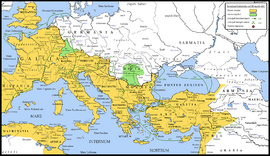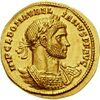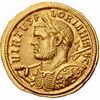أزمة القرن الثالث
| Crisis of the Third Century | ||||||||||
|---|---|---|---|---|---|---|---|---|---|---|
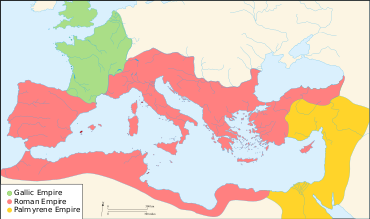 The divided Empire in 271 | ||||||||||
| ||||||||||
| المتحاربون | ||||||||||
| Roman Empire[أ] | Roman Breakaways |
Sasanian Empire Germanic Tribes | ||||||||
| القادة والزعماء | ||||||||||
|
|
Shapur I Cniva † | |||||||||
أزمة القرن الثالث، وتُعرف أيضاً بإسم الفوضى المسلحة أو الأزمة الامبراطورية، (235–284م) كانت فترة كادت فيها أن تنهار الامبراطورية الرومانية تحت الضغوط المتزامنة من الغزو، الحرب الأهلية، الطاعون، والكساد الاقتصادي. بدأت الأزمة باغتيال الامبراطور ألكسندر سڤروس على يد قواته، لتبدأ فترة خمسين عاماً تولى السلطة الامبراطورية 20–25 مدعي للقب الامبراطور، ومعظمهم جنرالات بارزون في الجيش الروماني على كل أو جزء من الامبراطورية.
بحلول 258–260، انقسمت الامبراطورية إلى ثلاث دول متنافسة: الامبراطورية الغالية، التي كانت تضم المقاطعات الرومانية غال، بريطانيا و(لفترة وجيزة) هسپانيا؛ امبراطورية تدمر، التي ضمت المقاطعات الشرقية سوريا پالستينا وإيگپتوس؛ والامبراطورية الرومانية، نفسها، المستقلة والمتركزة في إيطاليا، بينهما. ولاحقاً، أعاد أورليان (270–275) توحيد الامبراطورية؛ وانتهت الأزمة بصعود ديوكلتيان في 284 وتمريره لإصلاحاته.
أصفرت الأزمة عن تغيرات عميقة في مؤسسات الامبراطورية والمجتمع والحياة الاقتصادية وبالنهاية في الديانة، التي يتزايد نظر معظم المؤرخين إليها بأنها عرّفت الانتقال من القدم الكلاسيكي إلى القدم المتأخر.[1]
. . . . . . . . . . . . . . . . . . . . . . . . . . . . . . . . . . . . . . . . . . . . . . . . . . . . . . . . . . . . . . . . . . . . . . . . . . . . . . . . . . . . . . . . . . . . . . . . . . . . . . . . . . . . . . . . . . . . . . . . . . . . . . . . . . . . . . . . . . . . . . . . . . . . . . . . . . . . . . . . . . . . . . . .
التاريخ
| الأسر الإمبراطورية الرومانية | |||
| أزمة القرن الثالث | |||
| خط زمني | |||
| أباطرة الثكنات | 235–284 | ||
| الأسرة الگوردية | 238–244 | ||
| الأسرة الڤالرية | 253–261 | ||
| أباطرة غاليون | 260–274 | ||
| الأباطرة الإيليريون | 268–284 | ||
| الأسرة الكارية | 282–285 | ||
| الأباطرة البريتان | 286–297 | ||
| الخلافة | |||
| سبقها الأسرة السڤرية |
تبعها ديوكلتيان و الحكم الرباعي | ||
| الأسر الإمبراطورية الرومانية | |||
| أزمة القرن الثالث | |||
| خط زمني | |||
| أباطرة الثكنات | 235–284 | ||
| الأسرة الگوردية | 238–244 | ||
| الأسرة الڤالرية | 253–261 | ||
| أباطرة غاليون | 260–274 | ||
| الأباطرة الإيليريون | 268–284 | ||
| الأسرة الكارية | 282–285 | ||
| الأباطرة البريتان | 286–297 | ||
| الخلافة | |||
| سبقها الأسرة السڤرية |
تبعها ديوكلتيان و الحكم الرباعي | ||
سبعة وثلاثين رجلاً نودي بهم أباطرة في الخمسة والثلاثين عاماً الواقعة بين حكم الاسكندر سفيرس وأورليان. وقتل جرديان الثالث جنوده وهو يحارب الفرس (244)، وهزم ديسيوس Decius فليب العربي الذي خلفه على العرش وقتله في فرونا Verona (249)، وكان فليب هذا رجلاً من أهل إلبريا، وكان ثرياً مثقفاً مخلصاً لروما إخلاصاً خلقياً بالشرف الذي ناله في القصص القديم، وقد وضع فليب هذا في أثناء فترات السلم التي تخللت حرب القوط برنامجاً واسعاً ليعيد به إلى روما دينها وأخلاقها، وعاداتها الصالحة، وأصدر أوامره بالقضاء على المسيحية. ثم عاد إلى نهر الدانوب، والتقى بالقوط، وشهد بعينه مقتل ابنه إلى جانبه، وأعلن في جيشه الهياب المتردد أن خسارة فرد من الأفراد لا قيمة لها البتة، وهاجم جيش العدو وقتل هو في هزيمة من أقسى الهزائم التي أصابت الرومان في تاريخهم كله (251). وخلفه جالس Gllus الذي قتله جنوده (253)، وجاء بعدهما إيمليانس Aemilianus وقد قتله هو الآخر جنوده في العام نفسه.
وكان فالريان Valerian الإمبراطور الجديد في سن الستين، ولما جلس على العرش اضطر لملاقات الفرنجة، والألمان، والمركمان، والقوط، والسكوذيين، والفرس في وقت واحد ولهذا عين إبنه جلينس Glaienus حاكماً على الإمبراطوريّة الغربية، واحتفظ لنفسه بالشرق، وزحف بجيش على أرض النهرين ولكن كبر سنه أعجزه عن القيام بهذا الواجب الذي يحتاج إلى قوة أعظم من قوته فلم يلبث أن ناء به. وكان جلينس وقتئذ في الخامسة والثلاثين من عمره، وكان شجاعاً، ذكياً، مثقفاً ثقافة لا تكاد تتفق مع أحوال ذلك القرن المليء بالحروب الوحشية. وقد أصلح دولاب الإدارة المدنية في الغرب، وقاد جيشه من نصر إلى نصر على أعداء الإمبراطوريّة عدواً بعد عدو، ووجد مع ذلك متسعاً من الوقت يأخذ فيه بناصر الفلسفة والآداب، وأحيا الفن القديم إحياء لم يدم طويلاً، ولكن عبقريته المتعددة الجوانب لم تقوَ على مغالبة الشرور التي تجمعت في ذلك الوقت.
ففي عام 254، أغار المركمان على بنونية وشمالي إيطاليا، وفي عام 255 غزا القوط مقدونية ودلماشيا، وهاجم السكوذيون والقوط آسية الصغرى، وأغار الفرس على سوريا. وفي عام 257 استولى القوط على مملكة بسبورس، ونهبوا المُدن اليونانية الواقعة على شواطئ البحر الأسود، وحرقوا طرابزون، وساقوا أهلها عبيداً وإماء، وأغاروا على بنطس. وفي عام 258 استولوا على خلدقون، ونقوميديا. وبروصه، وأپاميا، ونيقية، واستولى الفرس في العام نفسه على أرمينية، ونادى بستيوس بنفسه حاكماً مستقلاً على غالة. وفي عام 259 أغار الألمان على إيطاليا، ولكن جالينس هزمهم عند ميلان. وفي عام 260 هزم الفرس فليريان عند الرها ومات أسيراً في زمان ومكان غير معروفين إلى اليوم. وتقدم شابور الأول وفرسانه الخفاف الكثيرين مخترقين سوريا إلى إنطاكية، وباغتوا أهلها وهم يشهدون الألعاب، ونهبوا المدينة، وقتلوا آلافاً من أهلها، وساقوا آلافاً آخرين عبيداً، واستولوا على طرسوس وخربوها، وعاثوا فساداً في قيليقية وكبدوكية، وعاد شابور إلى بلاد الفرس مثقلاً بالغنائم. وحلت بروما في مدى عشر سنين ثلاث مآس أذلتها وجللتها العار: ذلك أن إمبراطوراً رومانياً آخر لأول مرة صريعاً مهزوماً في ميدان القتال، وأسر العدو إمبراطوراً آخر وضحى بوحدة الإمبراطوريّة استجابة لضرورة ملاقاة الأعداء الذين أغاروا عليها من جميع الجهات. وضعضعت هذه الضربات وما صحبها من رفع الجنود الأباطرة على العرش واغتيالهم، أركان الإمبراطوريّة، وقضت على هيبتها، وفقدت هذه القوى النفسية التي أنزلها الزمان منزلة القداسة وخلع عليها سلطاناً يألفه الناس ولا يسألون عن مبارراته، تقول فقدت هذه القوى سيطرتها على أعداء روما بل فقدتها أيضاً على رعاياها ومواطنيها، فاندلع لهيب الثورة في كل مكان: ففي صقلية وغالة ثار الفلاحون الذين طال عليهم أمد الظلم ثورات عنيفة، وفي بنونيا نادى إنجينس بنفسه حاكماً مستقلاً على الولايات الشرقية. وفي عام 263 سار القوط بحراً بازاء سواحل أيونيا، ونهبوا إفسوس، وأحرقوا هيكل أرتميس الفخم، وساد الإرهاب جميع بلاد الشرق الهلنستي.
ولكن الإمبراطوريّة في آسية نجحت على يدي حليف غير متوقع. ذلك أن أوناثس، الذي كان يحكم تدمر خاضعاً لسلطان روما طرد الفرس من أرض الجزيرة، وهزمهم في طشقونة (261)، ونادى بنفسه ملكاً على سوريا وقليقلة، وبلاد العرب، وكبدوكية، وأرمينية. ثم اغتيل في عام 266، وورث ابن له شاب ألقابه، وورثت أرملته سلطانه.
وقد جمعت زنوبيا، كما جمعت كليوبطرة التي تدعي هي أنها من نسلها، إلى جمال الخلق، براعة في الحكم، وكثيراً من أسباب ثقافة العقل. وقد درست آداب اليونان وفلسفتهم، وتعلمت اللغات اليونانية، والمصرية، والسريانية، وكتبت تاريخاً لبلاد الشرق. ويلوح أنها جمعت بين العفة والقوة والنشاط، فلم تبح لنفسها من العلاقات الجنسية إلا ما يتطلبه واجب الأمومة(20). وعودت نفسها تحمل التعب والمشاق، وكانت تستمتع بأخطار الصيد، وتسير على قدميها أميالاً طوالاً على رأس جيشها. وجمعت في حكمها بين الحكمة والصرامة، وعينت الفيلسوف لنجيبس رئيساً لوزرائها، وأحاطت نفسها في بلاطها بالعلماء والشعراء والفنانين، وجملت عاصمة ملكها بالقصور اليونانية - الرومانية - الأسيوية التي يدهش لها عابر الصحراء في هذه الأيام.
وأحست أن الإمبراطوريّة تتقطع أوصالها، فاعتزمت إقامة أسرة حاكمة ودولة جديدتين، وأخضعت لسلطانها كبدوكية، وغلطية، والجزء الأكبر من بيثينيا، وأنشأت جيشاً عظيماً وعمارة بحرية ضخمة، فتحت بهما مصر واستولت على الإسكندرية بعد حصار هلك في نصف سكانها. وتظاهرت "ملكة الشرق الداهية" أنها تعمل نائبة عن الدولة الرومانية، ولكن العالم كله كان يدرك أن انتصاراتها لم تكن إلا فصلاً من مسرحية واسعة النطاق هي مسرحية انهيار روما.
وعرف البرابرة ثروة الإمبراطوريّة وضعفها، فتدفقوا على بلاد البلقان واليونان. وبينما كان السرماتيون يعيثون فساداً من جديد في المُدن القائدة على شواطئ البحر الأسود، وكان فرع من فروع القوط يسير في خمسمائة سفينة مخترقاً مضيق الهلسبنت إلى بحر إيجة، ويستولي على جزائره جزيرة في إثر جزيرة، ويرسو في ميناء بيريه، وينهب أثينة، وأرجوس، وإسبارطة وكورنثة، وطيبة (267). وبينما كان اسطولهم يعيد بعض المغيرين إلى البحر الأسود، كانت جماعة أخرى منهم تشق طريقها براً نحو موطنها على نهر الدانوب. والتقى بهم جالينس على نهر نستس في تراقية، وانتصر عليهم في معركة فيها كثيراً، ولكن جنوده اغتالوه بعد سنة واحدة من هذا النصر. وانقضت جموع أخرى من القوط في عام 269 على مقدونة وحاصرت تسالونيكي، ونهبت بلاد اليونان، ورودس، وقبرص، وشواطئ أيونيا. وأنقذ الإمبراطور كلوديوس الثاني تسالونيكي، وطرد القوط إلى أعالي وادي الواردار، وهزمهم عند نايسس (وهي نيش الحديثة) هزيمة منكرة قتل فيها منهم مقتلة كبيرة (269). ولو أنه خسر هذه المعركة لما وقف جيش بين القوط وإيطاليا.
الأسباب
Problem of succession and civil war
From the beginning of the Principate there were no clear rules for the imperial succession, largely because the empire maintained the facade of a republic.[2]
During the early Principate, the process for becoming an emperor relied on a combination of proclamation by the Senate, popular approval, and acceptance by the army, in particular the Praetorian Guard. A family connection to a previous emperor was beneficial, but it did not determine the issue in the way a formal system of hereditary succession would. From the Julio-Claudian dynasty onwards there was sometimes tension between the Senate's preferred choice and the army. As the Senatorial class declined in political influence and more generals were recruited from the provinces, this tension increased.
Whenever the succession appeared uncertain, there was an incentive for any general with support of a sizable army to attempt to seize power, sparking civil war. The most recent example of this prior to the Crisis was the Year of the Five Emperors which resulted in the victory of Septimius Severus. After the overthrow of the Severan dynasty, for the rest of the 3rd century, Rome was ruled by a series of generals, coming into power through frequent civil wars which devastated the empire.[3]
الكوارث الطبيعية
The first and most immediately disastrous of the natural disasters that the Roman Empire faced during the Third Century was the plague. The Antonine Plague that preceded the Crisis of the Third Century sapped manpower from Roman armies and proved disastrous for the Roman economy.[4] From 249 to 262, the Plague of Cyprian devastated the Roman Empire to such a degree that some cities, such as the city of Alexandria, experienced a 62% decline in population.[5] These plagues greatly hindered the Roman Empire's ability to ward off barbarian invasions but also factored into problems such as famine, with many farms becoming abandoned and unproductive.[6]
A second and longer-term natural disaster that took place during the third century was the increased variability of weather. Drier summers meant less agricultural productivity and more extreme weather events led to agricultural instability. This could also have contributed to the increased barbarian pressure on Roman borders, as they too would have experienced the detrimental effects of climate change and sought to push inward to more productive areas of the Mediterranean region.[7]
الغزوات الأجنبية
Barbarian invasions came in the wake of civil war, plague, and famine. Distress caused in part by the changing climate led various barbarian tribes to push into Roman territory. Other tribes coalesced into more formidable entities (notably the Alamanni and Franks), or were pushed out of their former territories by more dangerous peoples such as the Sarmatians (the Huns did not appear west of the Volga for another century). Eventually, the frontiers were stabilized by the Illyrian Emperors. However, barbarian migrations into the empire continued in greater and greater numbers. Though these migrants were initially closely monitored and assimilated, later tribes eventually entered the Roman Empire en masse with their weapons, giving only token recognition of Roman authority.[8]
The defensive battles that Rome had to endure on the Danube since the 230s, however, paled in comparison to the threat the empire faced in the East. There, Sassanid Persia represented a far greater danger to Rome than the isolated attacks of Germanic tribes.[9] The Sassanids had in 224 and 226 overthrown the Parthian Arsacids, and the Persian King Ardashir I, who also wanted to prove his legitimacy through military successes, had already penetrated into Roman territory at the time of Severus Alexander, probably taking the strategically important cities of Nisibis and Carrhae in 235/236.[10]
الوقع الاقتصادي
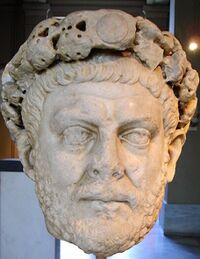
Internally, the empire faced hyperinflation caused by years of coinage devaluation.[11] This had started earlier under the Severan emperors who enlarged the army by one quarter,[12][نشر ذاتي سطري?] and doubled the base pay of legionaries. As each of the short-lived emperors took power, they needed ways to raise money quickly to pay the military's "accession bonus" and the easiest way to do so was by inflating the coinage severely, a process made possible by debasing the coinage with bronze and copper.
This resulted in runaway rises in prices, and by the time Diocletian came to power, the old coinage of the Roman Empire had nearly collapsed. Some taxes were collected in kind and values often were notional, in bullion or bronze coinage. Real values continued to be figured in gold coinage, but the silver coin, the denarius, used for 300 years, was gone (1 pound of gold = 40 gold aurei = 1,000 denarii = 4,000 sestertii).[بحاجة لمصدر] This currency had almost no value by the end of the third century, and trade was carried out without retail coinage.
Breakdown of the internal trade network
One of the most profound and lasting effects of the Crisis of the Third Century was the disruption of Rome's extensive internal trade network. Ever since the Pax Romana, starting with Augustus, the empire's economy had depended in large part on trade between Mediterranean ports and across the extensive road systems to the Empire's interior. Merchants could travel from one end of the empire to the other in relative safety within a few weeks, moving agricultural goods produced in the provinces to the cities, and manufactured goods produced by the great cities of the East to the more rural provinces.
Large estates produced cash crops for export and used the resulting revenues to import food and urban manufactured goods. This resulted in a great deal of economic interdependence among the empire's inhabitants. The historian Henry St. Lawrence Beaufort Moss describes the situation as it stood before the crisis:
Along these roads passed an ever-increasing traffic, not only of troops and officials but of traders, merchandise and even tourists. An interchange of goods between the various provinces rapidly developed, which soon reached a scale unprecedented in the previous history and not repeated until a few centuries ago. Metals mined in the uplands of Western Europe, hides, fleeces, and livestock from the pastoral districts of Britain, Spain, and the shores of the Black Sea, wine and oil from Provence and Aquitaine, timber, pitch and wax from South Russia and northern Anatolia, dried fruits from Syria, marble from the Aegean coasts, and – most important of all – grain from the wheat-growing districts of North Africa, Egypt, and the Danube Valley for the needs of the great cities; all these commodities, under the influence of a highly organized system of transport and marketing, moved freely from one corner of the Empire to the other.[13]
With the onset of the Crisis of the Third Century, however, this vast internal trade network broke down. The widespread civil unrest made it no longer safe for merchants to travel as they once had, and the financial crisis that struck made exchange very difficult with the debased currency. This produced profound changes that, in many ways, foreshadowed the very decentralized economic character of the coming Middle Ages.[14]
Large landowners, no longer able to successfully export their crops over long distances, began producing food for subsistence and local barter. Rather than import manufactured goods from the empire's great urban areas, they began to manufacture many goods locally, often on their own estates, thus beginning the self-sufficient "house economy" that would become commonplace in later centuries, reaching its final form in the manorialism of the Middle Ages. The common, free people of the Roman cities, meanwhile, began to move out into the countryside in search of food and better protection.[15]
Made desperate by economic necessity, many of these former city dwellers, as well as many small farmers, were forced to give up hard-earned basic civil rights in order to receive protection from large land-holders. In doing so, they became a half-free class of Roman citizen known as coloni. They were tied to the land, and in later Imperial law, their status was made hereditary. This provided an early model for serfdom, the origins of medieval feudal society and of the medieval peasantry. The decline in commerce between the imperial provinces put them on a path toward increased self-sufficiency. Large landowners, who had become more self-sufficient, became less mindful of Rome's central authority, particularly in the Western Empire, and were downright hostile toward its tax collectors. The measure of wealth at this time began to have less to do with wielding urban civil authority and more to do with controlling large agricultural estates in rural regions since this guaranteed access to the only economic resource of real value – agricultural land and the crops it produced. The common people of the empire lost economic and political status to the land-holding nobility, and the commercial middle classes waned along with their trade-derived livelihoods. The Crisis of the Third Century thus marked the beginning of a long gradual process that would transform the ancient world of classical antiquity into the medieval one of the Early Middle Ages.[16]
However, although the burdens on the population increased, especially the lower strata of the population, this cannot be generalized to the whole empire, especially since living conditions were not uniform. Although the structural integrity of the economy suffered from the military conflicts of that time and the inflationary episode of the 270s, it did not collapse, especially because of the complex regional differences. Recent research has shown that there were regions that prospered even further, such as Egypt, Africa and Hispania. But even for Asia Minor, which was directly affected by attacks, no general decline can be observed.[17] While commerce and the overall economy flourished in several regions, with several provinces not affected by hostilities, other provinces experienced some serious problems, as evidenced by personal hoards in the northwestern provinces of the empire. However, there can be no talk of a general economic crisis throughout the whole of Empire.[18]
Even the Roman cities began to change in character. The large cities of classical antiquity slowly gave way to the smaller, walled cities that became common in the Middle Ages. These changes were not restricted to the third century, but took place slowly over a long period, and were punctuated with many temporary reversals. In spite of extensive reforms by later emperors, however, the Roman trade network was never able to fully recover to what it had been during the Pax Romana (27 BC – AD 180). This economic decline was far more noticeable and important in the western part of the empire, which was also invaded by barbarian tribes several times during the century. Hence, the balance of power clearly shifted eastward during this period, as evidenced by the choice of Diocletian to rule from Nicomedia in Asia Minor, putting his second in command, Maximian, in Milan. This would have a considerable impact on the later development of the empire with a richer, more stable eastern empire surviving the end of Roman rule in the west.[19]
While imperial revenues fell, imperial expenses rose sharply. More soldiers, greater proportions of cavalry, and the ruinous expense of walling in cities all added to the toll. Goods and services previously paid for by the government were now demanded in addition to monetary taxes. The empire suffered from a crippling labour shortage. The steady exodus of both rich and poor from the cities and now-unprofitable professions forced Diocletian to use compulsion; conscription was made universal, most trades were made hereditary, and workers could not legally leave their jobs or travel elsewhere to seek better-paying ones. This included the unwanted middle-class civil service positions and under Constantine, the military. Constantine also tried to provide social programs for the poor to reduce the labour shortage.[20]
. . . . . . . . . . . . . . . . . . . . . . . . . . . . . . . . . . . . . . . . . . . . . . . . . . . . . . . . . . . . . . . . . . . . . . . . . . . . . . . . . . . . . . . . . . . . . . . . . . . . . . . . . . . . . . . . . . . . . . . . . . . . . . . . . . . . . . . . . . . . . . . . . . . . . . . . . . . . . . . . . . . . . . . .
Increased militarization
All the barracks emperors based their power on the military and on the soldiers of the field armies, not on the Praetorians in Rome. Thus, Rome lost its role as the political center of the empire during the third century, although it remained ideologically important. In order to legitimize and secure their rule, the emperors of the third century needed above all military successes.[21]
The centre of decision-making shifted away from Rome and to wherever the emperor was with his armies, typically, in the east. This led to the transfer of the capital to the four cities Milan, Trier, Nicomedia, and Sirmium, and then to Constantinople. The Senate ceased to be the main governing organ and instead members of the equestrian class who filled the military officer corps became increasingly prominent.[22]
الأباطرة
Several emperors who rose to power through acclamation of their troops attempted to create stability by giving their descendants the title of Augustus and so making them co-emperors who later succeeded to the throne after their death or on some occasions their relatives managed to become an emperor immediately after their death. This led to the creation of several brief dynasties.
Non-dynastic
| Portrait | Name | Birth | Succession | Reign | Death | Time in office |
|---|---|---|---|---|---|---|
| Maximinus Thrax CAESAR GAIVS IVLIVS VERVS MAXIMINVS AVGVSTVS |
c. AD 173, Thracia | Proclaimed emperor by Pannonian legions after Severus Alexander's assassination | ح. March 235 – June 238 | June AD 238 (aged 65) Assassinated by his own troops |
3 years |
Gordian dynasty
| Portrait | Name | Birth | Succession | Reign | Death | Time in office |
|---|---|---|---|---|---|---|
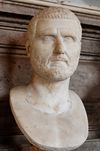
|
Gordian I CAESAR MARCVS ANTONIVS GORDIANVS SEMPRONIANVS AFRICANVS AVGVSTVS |
c. AD 159, Phrygia? | Proclaimed emperor, whilst Pro-consul in Africa, during a revolt against Maximinus Thrax. Ruled jointly with his son Gordian II, and in opposition to Maximinus. Technically a usurper, but retrospectively legitimized by the accession of Gordian III | ح. March – April 238 | April AD 238 Committed suicide upon hearing of the death of Gordian II |
22 days |
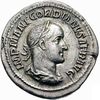
|
Gordian II CAESAR MARCVS ANTONIVS GORDIANVS SEMPRONIANVS ROMANVS AFRICANVS AVGVSTVS |
c. AD 192, ? | Proclaimed emperor, alongside father Gordian I, in opposition to Maximinus by act of the Senate | ح. March – April 238 | April AD 238 Killed during the Battle of Carthage, fighting a pro-Maximinus army |
22 days |
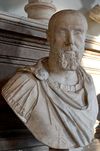
|
Pupienus (non-dynastic) CAESAR MARCVS CLODIVS PVPIENVS MAXIMVS AVGVSTVS |
c. AD 178, ? | Proclaimed joint emperor with Balbinus by the Senate in opposition to Maximinus | ح. April – July 238 | July 29, AD 238 Assassinated by the Praetorian Guard |
99 days |

|
Balbinus (non-dynastic) CAESAR DECIMVS CAELIVS CALVINVS BALBINVS PIVS AVGVSTVS |
? | Proclaimed joint emperor with Pupienus by the Senate after death of Gordian I and II, in opposition to Maximinus | ح. April – July 238 | July 29, AD 238 Assassinated by Praetorian Guard |
99 days |
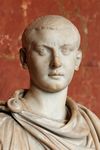
|
Gordian III CAESAR MARCVS ANTONIVS GORDIANVS AVGVSTVS |
January 20, AD 225, Rome | Proclaimed emperor by supporters of Gordian I and II, then by the Senate; caesar with Pupienus and Balbinus until July AD 238. Grandson of Gordian I | ح. July 238 – February 244 | February 11, AD 244 Unknown; possibly murdered on orders of Philip I |
5 years, 7 months |
Non-dynastic
| Portrait | Name | Birth | Succession | Reign | Death | Time in office |
|---|---|---|---|---|---|---|
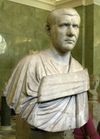
|
Philip the Arab CAESAR MARCVS IVLIVS PHILIPPVS AVGVSTVS with Philip II MARCVS IVLIVS SEVERVS PHILLIPVS AVGVSTVS |
c. AD 204, Shahba, Syria | Praetorian Prefect to Gordian III, took power after his death; made his son Philip II co-emperor in summer AD 247 | ح. February 244 – September 249 | September/October AD 249 (aged 45) Killed in the Battle of Verona by Decius |
5 years, 7 months |

|
Silbannacus
IMPERATOR MAR. SILBANNACHVS AVGVSTVS |
? | Unknown, but he may have been a usurper. | Unknown, possibly between c. 238 and c. 260 | ? | Unknown, likely very short |
Decian dynasty
| Portrait | Name | Birth | Succession | Reign | Death | Time in office |
|---|---|---|---|---|---|---|
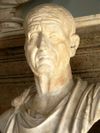
|
Trajan Decius CAESAR GAIVS MESSIVS QVINTVS TRAIANVS DECIVS AVGVSTVS with Herennius Etruscus |
c. AD 201, Budalia, Pannonia Inferior | Governor under Philip I; proclaimed emperor by Danubian legions then defeating and killing Philip in the Battle of Verona; made his son Herennius Etruscus co-emperor in early AD 251 | ح. September 249 – June 251 | June AD 251 Both killed in the Battle of Abrittus fighting against the Goths |
2 years |

|
Hostilian CAESAR CAIVS VALENS HOSTILIANVS MESSIVS QVINTVS AVGVSTVS |
Sirmium | Son of Trajan Decius, accepted as heir by the Senate | ح. June 251 – late 251 | September/October AD 251 Natural causes (plague) |
4–5 months |
. . . . . . . . . . . . . . . . . . . . . . . . . . . . . . . . . . . . . . . . . . . . . . . . . . . . . . . . . . . . . . . . . . . . . . . . . . . . . . . . . . . . . . . . . . . . . . . . . . . . . . . . . . . . . . . . . . . . . . . . . . . . . . . . . . . . . . . . . . . . . . . . . . . . . . . . . . . . . . . . . . . . . . . .
Non-dynastic
| Portrait | Name | Birth | Succession | Reign | Death | Time in office |
|---|---|---|---|---|---|---|
| Trebonianus Gallus CAESAR GAIVS VIBIVS TREBONIANVS GALLVS AVGVSTVS with Volusianus GAIVS VIBIVS VOLVSIANVS AVGVSTVS |
AD 206, Italia | Governor of Moesia Superior, proclaimed emperor by Danubian legions after Decius's death (and in opposition to Hostilian); made his son Volusianus co-emperor in late AD 251. | ح. June 251 – August 253 | August AD 253 (aged 47) Assassinated by their own troops, in favor of Aemilian |
2 years | |
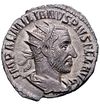
|
Aemilian CAESAR MARCVS AEMILIVS AEMILIANVS AVGVSTVS |
c. AD 207 or 213 Africa | Governor of Moesia Superior, proclaimed emperor by Danubian legions after defeating the Goths; accepted as emperor after death of Gallus | ح. August – October 253 | September/October AD 253 (aged 40 or 46) Assassinated by his own troops, in favor of Valerian |
2 months |
Valerian dynasty
| Portrait | Name | Birth | Succession | Reign | Death | Time in office |
|---|---|---|---|---|---|---|
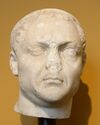
|
Valerian CAESAR PVBLIVS LICINIVS VALERIANVS AVGVSTVS |
c. AD 195 | Governor of Noricum and Raetia, proclaimed emperor by Rhine legions after death of Gallus; accepted as emperor after death of Aemilian | ح. October 253 – 260 | After AD 260 Captured in Battle of Edessa against Persians, died in captivity |
7 years |
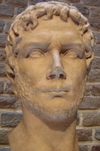
|
Gallienus CAESAR PVBLIVS LICINIVS EGNATIVS GALLIENVS AVGVSTVS with Saloninus |
AD 218 | Son of Valerian, made co-emperor in AD 253; his son Saloninus is very briefly co-emperor in c. July 260 before assassination by Postumus | ح. October 253 – September 268 | September AD 268 Murdered at Aquileia by his own commanders |
15 years |
الأسرة الكلاودية
| Portrait | Name | Birth | Succession | Reign | Death | Time in office |
|---|---|---|---|---|---|---|

|
Claudius II CAESAR MARCVS AVRELIVS CLAVDIVS AVGVSTVS |
May 10, AD 210, Sirmium | Victorious general at Battle of Naissus, seized power after Gallienus's death According to Epitome de Caesaribus he was a bastard son of Gordian II | ح. September 268 – January/April 270 | January/April AD 270 (aged 60) Natural causes (plague) |
1 year, 4–7 months |
| Quintillus CAESAR MARCVS AVRELIVS CLAVDIVS QVINTILLVS AVGVSTVS |
c. AD 210, Sirmium | Brother of Claudius II, seized power after his death | ح. April–May (?) 270 | AD 270 (aged around 60) Unclear; possibly suicide or murder |
17–77 days |
بدون أسر حاكمة
| Portrait | Name | Birth | Succession | Reign | Death | Time in office |
|---|---|---|---|---|---|---|
| Aurelian CAESAR LVCIVS DOMITIVS AVRELIANVS AVGVSTVS |
September 9, AD 214/AD 215, Sirmium | Proclaimed emperor by Danubian legions after Claudius II's death, in opposition to Quintillus | ح. May 270 – October 275 | September AD 275 (aged 60–61) Assassinated by Praetorian Guard |
5 years |
Tacitan dynasty
| Portrait | Name | Birth | Succession | Reign | Death | Time in office |
|---|---|---|---|---|---|---|
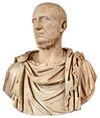
|
Tacitus CAESAR MARCVS CLAVDIVS TACITVS AVGVSTVS |
c. 200, Interamna Nahars, Italia | Elected by the Senate to replace Aurelian, after a short interregnum | ح. December 275 – June 276 | June AD 276 (aged 76) Natural causes (fever), possibly assassinated |
9 months |
| Florianus CAESAR MARCVS ANNIVS FLORIANVS AVGVSTVS |
? | Brother of Tacitus, elected by the army in the west to replace him | ح. June 276 – September 276 | September? AD 276 (aged ?) Assassinated by his own troops, in favor of Probus |
3 months |
Non-dynastic
| Portrait | Name | Birth | Succession | Reign | Death | Time in office |
|---|---|---|---|---|---|---|
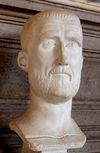
|
Probus CAESAR MARCVS AVRELIVS PROBVS AVGVSTVS |
AD 232, Sirmium | Governor of the eastern provinces, proclaimed emperor by Danubian legions in opposition to Florian | ح. September 276 – September AD 282 | September/ October AD 282 (aged 50) Assassinated by his own troops, in favor of Carus |
6 years |
Caran dynasty
| Portrait | Name | Birth | Succession | Reign | Death | Time in office |
|---|---|---|---|---|---|---|

|
Carus CAESAR MARCVS AVRELIVS CARVS AVGVSTVS |
c. AD 230, Narbo, Gallia Narbonensis | Praetorian Prefect to Probus; seized power either before or after Probus was murdered; made his son Carinus co-emperor in early AD 283 | ح. September 282 – July/August 283 | July/August AD 283 Natural causes? (Possibly killed by lightning) |
10–11 months |

|
Numerian CAESAR MARCVS AVRELIVS NVMERIVS NVMERIANVS AVGVSTVS |
? | Son of Carus, succeeded him jointly with his brother Carinus | ح. July/August 283 – November 284 | AD 284 Unclear; possibly assassinated |
1 year |
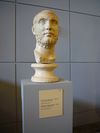
|
Carinus CAESAR MARCVS AVRELIVS CARINVS AVGVSTVS |
? | Son of Carus, ruled shortly with him and then with his brother Numerian | Spring 283– July 285 | July AD 285 Died in the Battle of the Margus |
2 years |
انظر أيضاً
- Bagaudae
- Sengoku period – a similar period in Japanese history
- Warring States period and Three Kingdoms period – similar periods in Chinese history (the latter roughly contemporaneous with the Crisis of the Third Century)
- Jublains archeological site documents some effects of the crisis in what is now western France
- Barbarian invasions of the 3rd century
ملاحظات
الهامش
- ^ Brown, P., The World of Late Antiquity, London 1971, p. 22.
- ^ "Res Publica Restituta? Republic and Princeps in the Early Roman Empire – Armstrong Undergraduate Journal of History". www.armstrong.edu (in الإنجليزية). Archived from the original on 2018-11-12. Retrieved 2018-10-19.
- ^ Freedman, Paul (Fall 2011). "The Crisis of the Third Century and the Diocletianic Reforms". Yale University. Archived from the original on 2017-12-08. Retrieved 2018-10-19.
- ^ Sabbatani, S.; Fiorino, S. (December 2009). "The Antonine Plague and the decline of the Roman Empire". Le Infezioni in Medicina: Rivista Periodica di Eziologia, Epidemiologia, Diagnostica, Clinica e Terapia delle Patologie Infettive. 17 (4): 261–275. ISSN 1124-9390. PMID 20046111.
- ^ Bernett, Rich (2020-08-22). "Systemic Problems that Led to the Crisis of the Third Century". Wondrium Daily (in الإنجليزية الأمريكية). Retrieved 2023-01-12.
- ^ Harper, Kyle (2017-11-01). "Solving the Mystery of an Ancient Roman Plague". The Atlantic (in الإنجليزية الأمريكية). Archived from the original on 2018-01-21. Retrieved 2018-10-20.
- ^ Büntgen, Ulf; Tegel, Willy; Nicolussi, Kurt; McCormick, Michael; Frank, David; Trouet, Valerie; Kaplan, Jed; Herzig, Franz; Heussner, Karl-Uwe; Wanner, Heinz; Luterbacher, Jürg; Esper, Jan (13 January 2011). "2500 Years of European Climate Variability and Human Susceptibility". Science (in الإنجليزية الأمريكية). 331 (6017): 578–582. Bibcode:2011Sci...331..578B. doi:10.1126/science.1197175. PMID 21233349.
- ^ Nigel., Rodgers (2006). Roman Empire. Dodge, Hazel. London: Lorenz Books. ISBN 978-0754816027. OCLC 62177842.
- ^ Josef Wiesehöfer: Das Reich der Sāsāniden, in Klaus Peter Johne, Udo Hartmann, Thomas Gerhardt, Die Zeit der Soldatenkaiser: Krise und Transformation des Römischen Reiches im 3. Jahrhundert n. Chr. (235–284) 2008, p. 531ff.
- ^ Erich Kettenhofen: Die Eroberung von Nisibis und Karrhai durch die Sāsāniden in der Zeit Kaiser Maximins, AD 235/236. In: Iranica Antiqua 30 (1995), pp. 159–177.
- ^ "This infographic shows how currency debasement contributed to the fall of Rome". Business Insider (in الإنجليزية). Archived from the original on 2017-10-11. Retrieved 2017-10-20.
- ^ Flichy, Thomas (28 September 2012). Financial crises and renewal of empires. Lulu.com. ISBN 9781291097337.قالب:Self-published source
- ^ Henry St. Lawrence Beaufort Moss (1935). The Birth of the Middle Ages 395–814. London: Oxford University Press. pp. 1.
- ^ H. St. L. B. Moss, The Birth of the Middle Ages (Clarendon Press, 1935, reprint Oxford University Press, 2000) ISBN 0-19-500260-1
- ^ H. St. L. B. Moss, The Birth of the Middle Ages (Clarendon Press, 1935, reprint Oxford University Press, 2000) ISBN 0-19-500260-1 pp. 29–30
- ^ H. St. L. B. Moss, The Birth of the Middle Ages (Clarendon Press, 1935, reprint Oxford University Press, 2000) ISBN 0-19-500260-1 pp. 26, 28–29
- ^ Ruffing, Kai (2006). Deleto paene imperio Romano: Transformationsprozesse des Römischen Reiches im 3. Jahrhundert und ihre Rezeption in der Neuzeit. Stuttgart: Steiner. p. 223. ISBN 978-3-515-08941-8. OCLC 180946164.
- ^ Hekster, Olivier. (2008). Rome and its Empire, AD 193–284. Edinburgh: Edinburgh University Press. p. 31. ISBN 978-0-7486-2992-3. OCLC 271165910.
- ^ H. St. L. B. Moss, The Birth of the Middle Ages (Clarendon Press, 1935, reprint Oxford University Press, January 2000) ISBN 0-19-500260-1 pp. 7, 30
- ^ Joseph Tainter (1988). The Collapse of Complex Societies. Cambridge University Press. p. 144. ISBN 052138673X.
- ^ Johne, Klaus-Peter; Hartmann, Udo; Gerhardt, Thomas (2008). Die Zeit der Soldatenkaiser: Krise und Transformation des Römischen Reiches im 3. Jahrhundert n. Chr. (235–284). Rome: Akademie Verlag. p. 1026. ISBN 978-3050045290.
- ^ Alaric Watson (2004). Aurelian and the Third Century. Routledge. pp. 14–15. ISBN 1134908156.
المراجع
- Hekster, O., Rome and its Empire, AD 193-284 (Edinburgh 2008) ISBN 978 0 7486 2303 7
- Klaus-Peter Johne (ed.), Die Zeit der Soldatenkaiser (Akademie Verlag, Berlin, 2008).
- Alaric Watson, Aurelian and the Third Century (Taylor & Francis, 2004) ISBN 0-415-30187-4
- John F. White, Restorer of the World: The Roman Emperor Aurelian (Spellmount, 2004) ISBN 1-86227-250-6
- H. St. L. B. Moss, The Birth of the Middle Ages (Clarendon Press, 1935, reprint Oxford University Press, January, 2000) ISBN 0-19-500260-1
- Ferdinand Lot, End of the Ancient World and the Beginnings of the Middle Ages (Harper Torchbooks Printing, New York, 1961. First English printing by Alfred A. Knopf, Inc., 1931).
للاستزادة
- Crisis of the Third Century, Hugh Kramer.
- Map, University of Calgary.
- The Crisis of the Third Century, OSU.
- CS1 الإنجليزية الأمريكية-language sources (en-us)
- Short description is different from Wikidata
- All articles with self-published sources
- Articles with self-published sources from February 2020
- Articles with unsourced statements from October 2008
- Articles with hatnote templates targeting a nonexistent page
- أزمة القرن الثالث
- القرن الثالث في الإمبراطورية الرومانية

